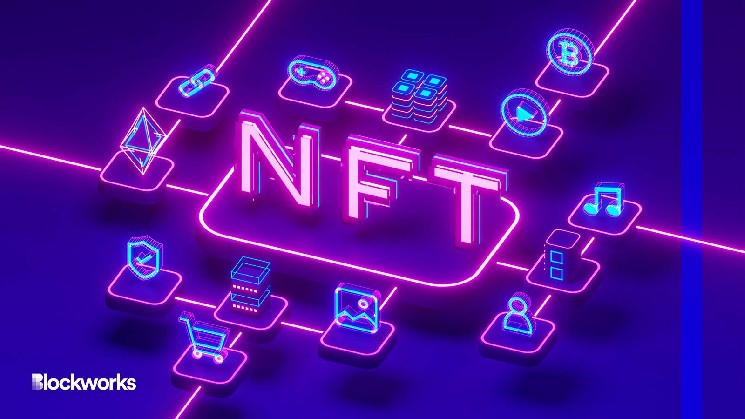6 Projects Using NFTs for Social Good

While the motivations of speculation and status may reign within the NFT community, there is another use case for Web3 projects that has been on display this year — social good.
NFT collections, metaverse activations and DAO fundraisers can all be leveraged to raise money for charitable causes, from environmental projects to humanitarian initiatives.
This holiday season, Blockworks rounded up some of the top examples of metaverse activations and NFT projects used for social good in 2022.
Preserving cultural heritage
Quantum Temple is a startup that is attempting to leverage Web3 to protect and preserve the cultural heritage of communities around the world.
By documenting culture and traditions in the form of NFTs, Quantum Temple hopes to raise awareness and appeal to conscious collectors and travelers who wish to support these communities. These digital assets are curated and verified by anthropologists.
UNESCO defines cultural heritage as oral traditions and expressions, performing arts, rituals and festive events, knowledge and practices concerning nature and the universe, and traditional craftsmanship.
For example, one of the first projects, currently in development, is a collection of cultural heritage NFTs focused on Bali, Indonesia that feature the ‘Cendrawasih’ dance, meaning the dance of the ‘Bird of Paradise.’ This ritual comes from Legong, a refined classical dance in Bali, and is based on the courtship rituals of Cendrawasih birds.
Professor Steve Lansing and adviser to the project said that this approach “opens up new ways for communities to share their heritage with the world and generates new revenue streams to directly benefit communities and artists” via NFT proceeds.
Videos of the Cendrawasih dance will be preserved for posterity on the Ethereum and Algorand blockchains and will benefit the Legong Dance School in Se Bali. Video and image files are stored on the Interplanetary File System (IPFS) distributed file storage protocol, the Quantum Temple team said, a common technique for NFTs projects involving media.
One of the dancers featured in the collection, Ni Kadek Virna Erikayani, said that she wishes “the international community to better understand my home culture and values, so that we can grow to respect each other, support each other, and understand each other.”
Web3 education
Upland, an EOS blockchain-based metaverse platform that is linked to geographical countries and cities, partnered with UNICEF Brazil to develop a virtual Web3 academy that provides technology training to Brazilian young adults.
Two UNICEF-branded structures have been built in the virtual Rio de Janeiro on Upland and a holiday NFT fundraiser is underway. Users can purchase the UNICEF Winter Gnomes and UNICEF Winter Ornaments to decorate their Upland homes and properties.
The sale’s proceeds will be used as a direct donation to the United Nations Children’s Fund, including dedicated funds to support and sponsor the education programs of UNICEF in Brazil, according to Upland.
UNICEF did not immediately return a request for comment.
Approximately 50% of proceeds from the Upland fundraiser power UNICEF’s One Million Opportunities (1MiO) program, which provides opportunities for professional training, employability and income generation for young adults (from 14 to 29 years old) in situations of vulnerability.
Students will be both physically and virtually trained in the basics of Web3, blockchain technology, smart contracts and metaverse fundamentals, according to Upland.
Courses will teach students digital skills when it comes to using the Upland metaverse, as well as how to apply those learning to crypto staking, tokenization and other Web3 related education. There will also be classes to learn entrepreneurial skills and on how to identify job opportunities in the metaverse economy and Web3 industry.
“In partnership with @unicefbrasil, we’re excited to create an opportunity for Brazil’s youth to learn how to create the same opportunities for themselves through a multi-touch web3 experience showcasing fun [CONT.] pic.twitter.com/zXBjEpp6zC
— Upland (@UplandMe) December 21, 2022
Healthcare in Africa
NFTs are being used to tackle the UN’s sustainable development goals when it comes to healthcare. The Women in Innovation Fund (WiN Fund), co-founded by Reckitt, is using the proceeds from NFTs sales to invest in women-led healthcare startups in Africa, addressing the UN’s third such goal — good health and well-being.
The benefits of blockchain for healthcare and democracy are being explored in countries with unstable leadership.
Women are more attuned to the healthcare needs of their community, according to Corinne Momal-Vanian, the executive director of the Kofi Annan Foundation. “Women entrepreneurs — from what we’ve seen in Africa — can drive innovation, can drive efficiency and can really have a place in the healthcare ecosystem that governments cannot fill,” she said at a UN-adjacent roundtable discussion in New York in September.
WiN Fund co-founder Pradeep Kakkattil, pointed to a worrying statistic: Only 2% of venture capital investments globally go to women-led enterprises, despite the fact that women-led businesses deliver 35% higher returns and create 6 times more jobs.
Celebrating differences
The Sandbox and the organization People of Crypto Lab (POC) debuted the ‘Valley of Belonging.’’ They described it as a ‘cultureverse’ or a diversity, equity and inclusivity hub in the metaverse that highlights the importance of an equitable Web3 community. That means using their virtual space to amplify creators, developers and brands that represent people of all races, ethnicity and backgrounds.
Their first project onboarded the cosmetics brand NYX Professional Makeup in The Sandbox to celebrate Pride Month via an 8,430 NFT avatar collection featuring voxelized makeup looks on the avatars.
Avatar traits included over 36 skin shades and eight NYX looks to show that makeup has no gender or sexual orientation. Additional customizable traits ranged from prosthetic limbs to various Muslim head coverings such as the hijab.
This activation even sought to represent handicapped community members by including non-player characters (NPCs) in wheelchairs, guiding players through special quests and mini games.
NYX donated 100% of its proceeds amounting to $50,000 from the sold out sale of the avatar NFTs to the Los Angeles LGBT Center.
Wildlife conservation
Netherlands-based decentralized carbon credit exchange Coorest and conservation consulting firm PLCnetwork of the Southern Hemisphere teamed up to tokenize individual real-world endangered animals at game reserves and privately owned conservation areas in Africa. These wildlife NFTs enable holders to sponsor an elephant, lion, cheetah or rhino. Profits from the sales will go toward food, shelter and security for the animals they represent.
Coorest — best known for operating an NFTrees CO2 compensation system that tokenizes yield-bearing assets or bonds and carbon credits that are tradable on the blockchain — partnered with PLCnetwork of the Southern Hemisphere with connections to wildlife reserves in South Africa, Zimbabwe and Botswana.
According to PLCnetwork founder Dr. Julia Baum, the main issue with on the ground wildlife conservation is that “it is costly and resources are often very limited.” Even for a private reserve with a generally bigger budget, the cost of taking care of an African bush elephant, for example, can be very expensive because it includes fencing, monitoring, 24-hour anti-poaching patrols and veterinary support.
Owning an “elephaNFT” or a “lioNFT” does not give ownership over the animals, rather it provides monthly “proof-of-life” verification that the animal is still alive. The metadata of each NFT contains information about the species, age and gender, specific to each tokenized animal. Holders will also be invited to visit the wildlife reserve and meet the animals. 70% of the funds from these Wildlife NFTs go to the game reserve or conservation area, with the funds released on a monthly or set schedule.
Support for Ukraine
Crypto donors flocked towards Ukraine supporting causes when the Russian-Ukraine war started in February, and tested the power of DAOs (decentralized autonomous organizations) as fundraising tools.
Ukraine DAO ended up raising $8 million in only a couple of days from the sale of an NFT of the Ukrainian flag. Proceeds went towards nonprofits and non-governmental organizations. Ukrainian-born activist Alona Shevchenko reached out to Pussy Riot’s Nadya Tolokonnikova to organize the group.
After only two weeks of conflict, over 102,000 crypto asset donations, totaling $54.7 million in ether, bitcoin and tether, were tracked, supporting the Ukrainian government and Come Back Alive, an NGO providing support to the military.
The government turned to Twitter to ask people to donate crypto. It even founded a nonprofit war fund — Aid For Ukraine — which reported spending $54 million of its crypto donations on military hardware by August. Founded by Ukraine’s Ministry of Digital Transformation in March, around $11 million went to unmanned aerial vehicles, followed closely by armor vests, computer hardware and software.
Another organization that raised an emergency response fund for Ukraine is The Giving Block — a crypto donation platform that provides charities with back-end support.
According to The Giving Block, ether was the most-donated cryptocurrency in 2021, totaling $30.79 million.
2022 saw countless more Web3 projects and fundraising efforts as blockchain technology sought to impact all kinds of industries from education and healthcare to beauty. Whether it’s NFT or DAO fundraisers or metaverse activations, blockchain technology has its benevolent side.






 Bitcoin
Bitcoin  Ethereum
Ethereum  Tether
Tether  USDC
USDC  TRON
TRON  Dogecoin
Dogecoin  Cardano
Cardano  Bitcoin Cash
Bitcoin Cash  Chainlink
Chainlink  LEO Token
LEO Token  Stellar
Stellar  Monero
Monero  Zcash
Zcash  Litecoin
Litecoin  Hedera
Hedera  Dai
Dai  Cronos
Cronos  OKB
OKB  Tether Gold
Tether Gold  Ethereum Classic
Ethereum Classic  KuCoin
KuCoin  Gate
Gate  Algorand
Algorand  Cosmos Hub
Cosmos Hub  VeChain
VeChain  Dash
Dash  Tezos
Tezos  Stacks
Stacks  TrueUSD
TrueUSD  IOTA
IOTA  Basic Attention
Basic Attention  Theta Network
Theta Network  Decred
Decred  NEO
NEO  Qtum
Qtum  Synthetix
Synthetix  Ravencoin
Ravencoin  0x Protocol
0x Protocol  DigiByte
DigiByte  Zilliqa
Zilliqa  Nano
Nano  Numeraire
Numeraire  Siacoin
Siacoin  Waves
Waves  Ontology
Ontology  Enjin Coin
Enjin Coin  Status
Status  BUSD
BUSD  Hive
Hive  Pax Dollar
Pax Dollar  Lisk
Lisk  Steem
Steem  Huobi
Huobi  NEM
NEM  OMG Network
OMG Network  Augur
Augur  Bitcoin Gold
Bitcoin Gold  Ren
Ren  Bitcoin Diamond
Bitcoin Diamond